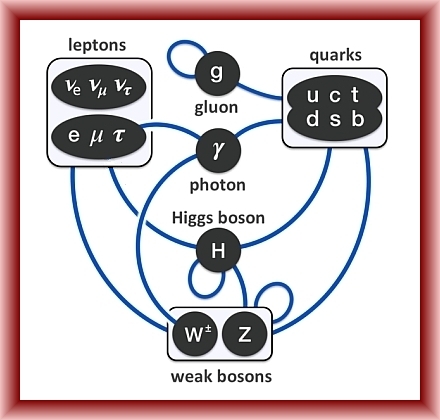Can We Understand The Standard Model?
Posted by John Baez
I’m giving a talk in Latham Boyle and Kirill Krasnov’s Perimeter Institute workshop Octonions and the Standard Model on Monday April 5th at noon Eastern Time.
This talk will be a review of some facts about the Standard Model. Later I’ll give one that says more about the octonions.
Can we understand the Standard Model?
Abstract. 40 years trying to go beyond the Standard Model hasn’t yet led to any clear success. As an alternative, we could try to understand why the Standard Model is the way it is. In this talk we review some lessons from grand unified theories and also from recent work using the octonions. The gauge group of the Standard Model and its representation on one generation of fermions arises naturally from a process that involves splitting 10d Euclidean space into 4+6 dimensions, but also from a process that involves splitting 10d Minkowski spacetime into 4d Minkowski space and 6 spacelike dimensions. We explain both these approaches, and how to reconcile them.
You can see the slides here, and later a video of my talk will appear. You can register to attend the talk at the workshop’s website.
Here’s a puzzle, just for fun. As I’ll explain, there’s a normal subgroup of that acts trivially on all known particles, and this fact is very important. The ‘true’ gauge group of the Standard Model is the quotient of by this normal subgroup.
This normal subgroup is isomorphic to and it consists of all the elements
where
is my favorite primitive 6th root of unity, is my favorite primitive square root of unity, and
is my favorite primitive cube root of unity. (I’m a primitive kind of guy, in touch with my roots.)
Here I’m turning the numbers into elements of by multiplying them by the identity matrix, and turning the numbers into elements of by multiplying them by the identity matrix.
But in fact there are a bunch of normal subgroups of isomorphic to . By my count there are 12 of them! So you have to be careful that you’ve got the right one, when you’re playing with some math and trying to make it match the Standard Model.
Puzzle 1. Are there really exactly 12 normal subgroups of that are isomorphic to ?
Puzzle 2. Which ones give quotients isomorphic to the true gauge group of the Standard Model, which is modulo the group of elements ?
To help you out, it helps to know that every normal subgroup of is a subgroup of its center, which consists of the matrices . Similarly, every normal subgroup of is a subgroup of its center, which consists of the matrices and . So, the center of is .
Here, I believe, are the 12 normal subgroups of isomorphic to . I could easily have missed some, or gotten something else wrong!
The group consisting of all elements .
The group consisting of all elements .
The group consisting of all elements .
The group consisting of all elements .
The group consisting of all elements .
The group consisting of all elements .
The group consisting of all elements .
The group consisting of all elements .
The group consisting of all elements .
The group consisting of all elements .
The group consisting of all elements .
The group consisting of all elements .


Re: Can We Understand The Standard Model?
These are very interesting relations between the Standard Model group and the 10d Euclidean/Minkowski spacetimes, but beside the efort to understand the algebro-geometric origin of the SM group, it is also important to understand the representation of the SM group which gives the known elementary particles, as well as the different generations. Because it is not only the group/algebra which is important, but also a representation as well, one needs some category theory. For one such attempt, please see Standard Model and 4-groups, A. Mikovic and M. Vojinovic.